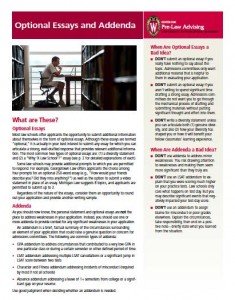Optional Essays:
Two Most Common Optional Essays
When Are Optional Essays a Bad Idea?
Addenda:
“[P]art of what we value—and that we actually evaluate for—is capacity for good judgment. And one way to display good judgment is in the decision that one makes in what essays to submit, whether you do optional essays, whether you submit addenda, and whether those optional essays and addenda are actually useful to us.… [T]hese are invitations to submit information if you have something important to say. And really, it’s not at all expected, and it actually could be harmful to actually submit several addenda that speak to different issues, that really don’t provide much helpful information other than what’s there already.”
Bill Hoye, Associate Dean of Admissions, Duke University School of Law
